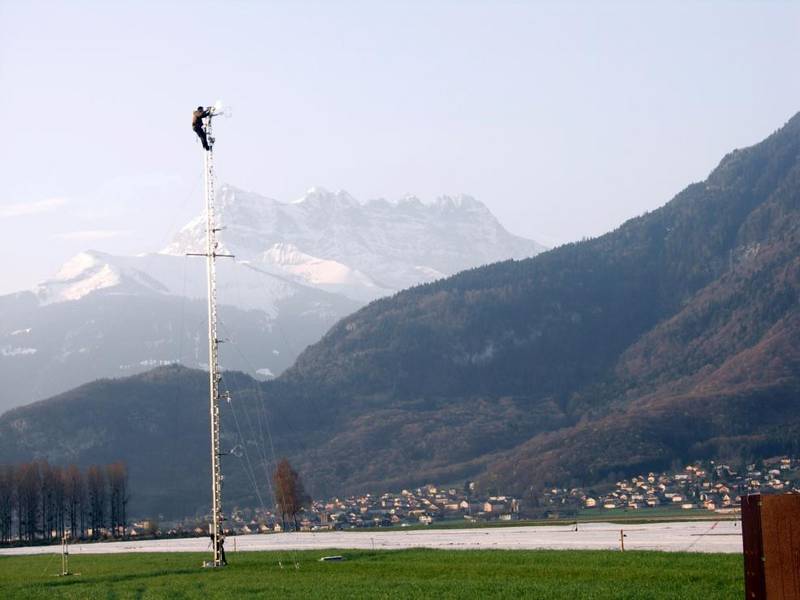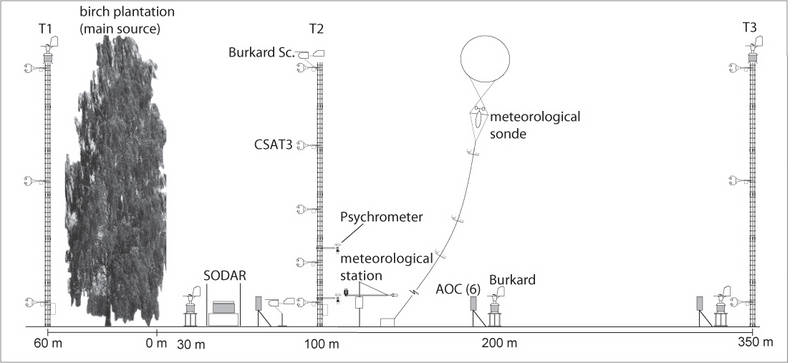
One of the three profile towers downwind of the source with a pollen sampler on top o fit and at the ground.

Longitudinal view of the set-up.

Longitudinal and lateral downwind pollen concentration distribution measured at 2 m above the ground.
|
|
MicroPoem
Impact of micrometeorological factors on birch pollen emission.
Project description
Within the COST Action ES0603 (EUPOL) one working group focuses on pollen production and release and their quantitative description. It includes analysis of observational and modeling information for revealing key characteristics of these processes. The project MicroPoem, a collaboration of the Institute of Meteorology, Climatology and Remote Sensing (MRC Lab), University of Basel and MeteoSwiss, aims at the investigation of the impact of micrometeorological factors on birch pollen emission. A second objective is the determination of pollen emission parameters, which will be implemented in pollen forecast models.
Diseases due to aeroallergens are among the major causes of a growing rate of health problems and morbidity. Adequate protective and pre-emptive measures require both the reliable assessment of production and release of various pollen species and the forecasting of their atmospheric dispersion. A new generation of pollen forecast models is being developed in various European countries. The emission parameter is one of the least known parts of these pollen forecast systems. The overall goal of the project MicroPoem is to investigate pollen production and emission by combining experimental and modeling work in order to quantify the released pollen in connection with meteorological factors. As an example, birch trees are used because their pollen is among the most important allergens in Europe.
Experimental data were collected in a large field campaign, which has been conducted in April 2009 in Illarsaz (Switzerland). Pollen concentrations and meteorological factors have been measured up- and downwind of a well-defined birch pollen source in a high spatial and temporal resolution. Key features of the set-up are the horizontal as well as vertical profiles of meteorological and pollen concentration measurements. The vertical profiles were measured at three towers and a tethered balloon. The set-up is unique to date and gives detailed information on the impact of micrometeorological factors on birch pollen emission. The resulting emission parameter will be tested using state-of-the-art atmospheric transport models and will considerably improve the quality of pollen forecasts.
COST Action ES0603: Assessment of production, release, distribution and health impact of allergenic
pollen in Europe
The main objective of the Action is to set up a multi-disciplinary forum for critical review of existing information on allergenic pollen in Europe and its representation in assessment and forecasting systems.
The Action will concentrate on:
- identification of the critical gaps in the current knowledge
- better co-ordination ofon-going research
- development of a comprehensive strategy and specific action plan for improving the scientific knowledge and converting the findings into integrated assessment systems
- strengthening the dialogue with end users
- Specific research directions will be: pollen production and release, pollen transport, transformation and interaction, applications and collaboration with end users.
Links
COST
COST Action ES0603 (EUPOL)
MicroPoem (MeteoSwiss contribution)
Project partner:
Federal Office of Meteorology and Climatology MeteoSwiss
Involved persons at MCR Lab:
Dominik Michel
Roland Vogt
|


